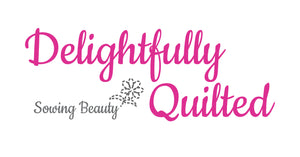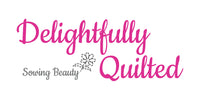design
When I design a quilt there are several core principles I follow:
FIRST, I really consider who I am designing it for and where it will be going.
• Baby and children quilts are designed to fit seamlessly in a nursery or child's room.
• Lap quilts are designed to be a focal point in your living room. I like to use bolder colors and stunning color arrangements for these.
• Bed size quilts use more subtle colors to be a peaceful addition to your bedroom, with a few fun quilts in the mix to spice things up.
SECOND, the design aesthetic I tend to lean toward is simple beauty. I love combinations of solids, tone on tone or low volume prints, and a larger focal point fabric.
FINALLY, I combine the first two principles by applying my 'simple beauty' aesthetic to current design trends and colors.
• I do this by looking through pattern books, home décor and design magazines, and observing popular trends in stores to get inspiration.
Once I've developed the basic idea or color scheme, I sketch out ideas in a notebook and start considering what fabrics and batting the quilt should be made from.
We use Electric Quilter 8 as a tool for designing quilts. It's very useful for planning the quilts offered across many sizes. That way we can visualize the best proportion of pattern to quilt size from baby through king.

more about design and materials standards
top piecing
After finalizing the fabrics the cutting begins. Then sewing. And cutting. Then sewing them back together. And back and forth until the top is complete.
The video below takes you through the start-to-finish process of making a quilt
The three main processes within top-piecing are cutting, sewing, and pressing. Each are important to the finished top.

Cutting is critical to accurate piecing. An error introduced during cutting will carry through to the finished top. That is why I use multiple rulers (and a good rotary cutter) to make sure I have the best tool for what I'm cutting.
For example, the Creative Grids flying geese ruler is my go-to for flying geese. With it, I haven't clipped a wing yet!
All the careful cutting in the world won't matter without accurate sewing. And that is where the 1/4-inch seam comes into play. The 1/4-inch overlap between pieces is one of the nearly unbreakable rules of quilting. The reason is durability - a seam less than 1/4-inch will tend to come apart, especially after repeated washings.
To make sure I have a 1/4-inch seam every time, I use a sewing machine attachment specifically designed for quilting.


Once two pieces of fabric, or two 'sub-assemblies' are joined together, the seams are pressed.
Taking the time to perform this step makes sure that the finished top comes together with flat seams without bumps or ridges.
top quilting and finishing
Next comes the washing and ironing of the backing, making the binding and selecting the batting. Then contemplating what will look best for top quilting based on the top piecing.
• Rather than using only all-over, or edge-to-edge designs, I like to adapt each top-quilting design to the pattern of the quilt top.
• For complex or more modern piecing (like the "Love Birds") the top quilting is more simple.
• But for simple patterns (like "The Classic") the top-quilting is more complex.
The video below shows the process of setting up and top-quilting a crib-sized quilt.
Long-arming provides several advantages:
• it makes the top quilting easier than on a standard sewing machine,
• it is more accurate than a standard sewing machine, and
• it is much faster than hand quilting - enabling me to create more quilts, and therefore serve more people.
The main steps of long-arming are:
(1) washing and ironing the quilt backing,
(2) loading the backing, batting, and top onto the frame,
(3) stitching the top quilting onto the available section of the quilt,
(4) rolling a new section into place and continuing to quilt.
The last two steps are repeated until the whole quilt has been top-quilted, and it is taken off the frame.

By taking advantage of computer automation through Handi-Quilter's ProStitcher program, I have been able to produce elegant top-quilting and quickly adapt it across the different sizes (such as the different block sizes in "The Classic")
After long-arming is complete, the quilt is 'squared' - that is, trimmed to have square corners and straight edges - and the binding and tag are added.
Every quilt is finished with a 'double-binding.' This type of binding improves strength around the edges. Additionally, my bindings are machine-stitched on the top and bottom.
Many quilt bindings are hand-stitched on the backside to avoid machine stitching coming through to the front. However, I use an invisible thread which avoids this problem.

With the binding and tag added, the quilt is officially finished and ready to be packed!
Like Seeing Behind The Scenes?
Have a Question about our Process?
Use this form to let us know - and we may answer it in the newsletter!

